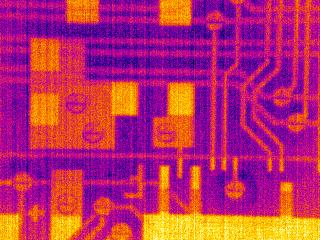Introduction
Four electrical grade wafers were delivered, plus one that was damaged during fabrication. Each wafer has three hybrids, hence the electrical grade wafers have 12 hybrids and two of the hybrids on the damaged wafer are not affected by the damage. Initial connectivity test with probe needles gave the following results- All 14 hybrids show a short between power and ground, with a resistance dominated by the contact resistance of the needles.
- None of the signal lines seem to be shorted to ground (veryfied on one hybrid)
- A selection of signal lines were probed on one hybrid, all where connected correctly.
Thermal imaging, Wafer 08, Hybrid 2
This is the middle hybrid of the damaged wafer. The GND and PWR pads on the power end of the hybrid were connected with 17 bond wires and the voltage difference between the GND and PWR plane was monitoried on the signal end of the hybrid. The V/I characteristics and corresponding resistance are shown below.The graph called Vin is the voltage at the input on the power end, and Vmon is the voltage measured at the signal end.
 The current was scanned many times up to increasing maximum values. Two hot-spots were became visible on the hybrid after a few power cycles.
The current was scanned many times up to increasing maximum values. Two hot-spots were became visible on the hybrid after a few power cycles.
 After a few power cycles up to maximums between 5 and 10 A, the the lower hotspot disappeared, but the short remained.
After a few power cycles up to maximums between 5 and 10 A, the the lower hotspot disappeared, but the short remained.
 These two spots don't correspond to any particular features in the layout.
These two spots don't correspond to any particular features in the layout.
 After a further few cycles the short disappeared, and a small crater is visible on the location of the upper hot spot. No damage is visible on the location of the other hot spot.
After a further few cycles the short disappeared, and a small crater is visible on the location of the upper hot spot. No damage is visible on the location of the other hot spot.


Thermal imaging, Wafer 08, Hybrid 1
The same measurements were repeated with hybrid 1 on wafer 8, but this time with a solder connection and only on the power end of the hybrid. The V/I characteristics are shown below.
 The difference in measured resistance (77 vs. 238 mOhm) could be due to the contact resistance. The hybrid was powered repeatedly up to 10 A but no hot spots were visible. All heat dissipation seem to be at the power pads of the hybrids.
The difference in measured resistance (77 vs. 238 mOhm) could be due to the contact resistance. The hybrid was powered repeatedly up to 10 A but no hot spots were visible. All heat dissipation seem to be at the power pads of the hybrids.


Comparison w08, Hybrid 1 & 2
High resolution images of the same location of Hybrid 1 and 2, both with 5 A current.

Thermal imaging, Wafer 01, Hybrid 1
Hybrid 1 on wafer 01 was powered using spring loaded pins on a custom made powering jig. The power supply was in current control mode and the following hotspot was seen at Iin=100 mA and Vin=0.835 V. The pictures show an overview thermal image and a high resolution image of the area, with and without power.

 The short had an approximate resistance of 8 Ohms and almost disappeared at 150 mA current. It was transformed in to a 15 Ohm short that then disappeared at 150 mA. No visible damage is seen in the area (see photo below). The circuit was powered with 35 V between PWR and GND planes for 15 minutes and the measured current was approximately 50 uA.
The short had an approximate resistance of 8 Ohms and almost disappeared at 150 mA current. It was transformed in to a 15 Ohm short that then disappeared at 150 mA. No visible damage is seen in the area (see photo below). The circuit was powered with 35 V between PWR and GND planes for 15 minutes and the measured current was approximately 50 uA.

Thermal imaging, Wafer 01, Hybrid 2
Hybrid 1 on wafer 01 was powered using spring loaded pins on a custom made powering jig. The power was supplied in current control mode via the power pads in both ends and at 4A and 362 mV the following hotspot was observed. This is a high resolution image of the area at 7A and 680mV and without power
This is a high resolution image of the area at 7A and 680mV and without power

 The short had an approximate resistance of 0.1 Ohm and was burnt away at 9A and 1.04 V. A second short with much higher resistance (approximately12 Ohms) then became visible, here shown at 100mA and 1.17V.
The short had an approximate resistance of 0.1 Ohm and was burnt away at 9A and 1.04 V. A second short with much higher resistance (approximately12 Ohms) then became visible, here shown at 100mA and 1.17V.


 The short disappeard at 250 mA with no visible damage in the area. The hybrid was powered with 35 V between GND and PWR for 15 minutes and the current was approximately 10 uA.
The short disappeard at 250 mA with no visible damage in the area. The hybrid was powered with 35 V between GND and PWR for 15 minutes and the current was approximately 10 uA.
Wafer 01 Hybrid 3
Hybrid 3 on wafer 1 was powered up to 3 A (Vin = 359 mV @ 3A) without showing any hotspots. Unfortunately the power supply pad burnt out which prevented further investigation of the hybrid. -- LarsEklund - 2010-07-21Topic revision: r3 - 2013-12-17 - AndrewPickford
Ideas, requests, problems regarding TWiki? Send feedback


